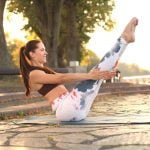Yoga has gained immense popularity as a fitness activity in recent years, and for good reason. Not only does it offer a wide range of physical benefits, but it also caters to people of all fitness levels. Whether you are a beginner or an advanced practitioner, yoga can be customized to meet your specific needs and goals.
No matter what your current fitness level is, yoga provides numerous benefits that can help improve your overall well-being. It allows individuals to develop strength, flexibility, balance, and endurance over time, all while promoting relaxation and stress relief. But what makes yoga so appealing is its adaptability to different fitness levels.
Understanding the various fitness levels is crucial when approaching yoga practice. Beginners can benefit from gentle yoga, which focuses on slower movements and emphasizes proper alignment. This gentle approach not only builds strength but also helps improve flexibility and mobility without putting excessive strain on the body.
For those who have limited flexibility or strength, modified poses provide a great starting point. These variations allow individuals to gradually build their capabilities while still experiencing the benefits of the practice. By using props or adjusting body positioning, modified poses ensure that everyone can participate in yoga regardless of their initial fitness level.
As individuals progress in their fitness journey and become more comfortable with their practice, they may opt for power yoga. This dynamic form of yoga focuses on building stamina and toning muscles through faster-paced movements and challenging sequences. Advanced practitioners often find power yoga beneficial for improving cardiovascular health and pushing their physical limits.
Understanding Different Fitness Levels
When it comes to yoga, it is essential to recognize that people have different fitness levels. Understanding these fitness levels can greatly impact one’s approach to yoga and determine the type of practice that will be most beneficial. Whether you are a beginner, an advanced practitioner, an athlete, or an older adult, there is a yoga practice suitable for your fitness level.
For beginners or individuals with limited mobility, gentle yoga can be the perfect starting point. Gentle yoga focuses on slow movements and stretching, making it accessible for those who may have physical limitations or are new to fitness. This type of yoga helps improve flexibility, strength, and balance while promoting relaxation and stress relief.
Modified poses are also important for beginners or individuals with limited flexibility or strength. These modified poses provide alternative variations of traditional yoga poses that make them more accessible without compromising the benefits. For example, if a person struggles with hamstring flexibility, they can use blocks or blankets to support themselves in standing forward folds or downward-facing dog pose. By modifying poses according to individual needs, beginners can gradually build strength and flexibility without feeling overwhelmed.
On the other end of the spectrum, power yoga is ideal for individuals with higher fitness levels who seek more intensity in their practice. Power yoga focuses on strength-building poses combined with faster-paced movements and dynamic sequences. This type of practice improves stamina, increases muscle tone, and enhances overall physical performance.
Regardless of one’s fitness level, incorporating yoga into a training regimen can be highly beneficial for athletes. Yoga helps athletes improve flexibility and range of motion while strengthening stabilizing muscles that may not be targeted during regular training activities. Furthermore, by emphasizing proper alignment and balance poses like tree pose or warrior III pose (Virabhadrasana), athletes can develop better body awareness and reduce the risk of injuries by correcting imbalances.
Gentle Yoga for Beginners
Yoga is a popular fitness activity that offers numerous benefits for individuals of all fitness levels. For those who are new to fitness or have limited mobility, gentle yoga can be an excellent option. Gentle yoga focuses on slow and controlled movements, making it accessible for beginners or individuals with physical limitations. Here are some key benefits of gentle yoga for beginners:
1. Improved Flexibility: Gentle yoga poses gently stretch and lengthen the muscles, helping to improve flexibility over time. This can be particularly beneficial for individuals who have been sedentary or have tight muscles due to lack of exercise.
2. Joint Mobility: Gentle yoga movements help to increase the range of motion in joints, promoting better joint health and reducing the risk of stiffness or discomfort. This is especially important for older adults or those with certain medical conditions like arthritis.
3. Stress Reduction: One of the main advantages of gentle yoga is its ability to promote relaxation and reduce stress. Through deep breathing techniques and mindful movements, practitioners can experience a sense of calmness and mental clarity, which can be especially helpful for those navigating the challenges of starting a new fitness routine.
If you are new to fitness or have limited mobility, it is important to approach gentle yoga with care and listen to your body’s needs. Always start with beginner-friendly classes or videos led by certified instructors who understand how to modify poses and provide proper guidance. Additionally, it is crucial to communicate any concerns or limitations you may have with your instructor beforehand, so they can provide appropriate modifications or alternatives during the practice.
Modified Poses for Beginners
Yoga is an accessible fitness activity that can be enjoyed by individuals of all fitness levels, including beginners with limited flexibility or strength. For those who are new to yoga or have physical limitations, modified poses offer a great way to gradually build strength and improve flexibility. These modified poses help beginners ease into the practice while still reaping numerous health benefits.
One of the key aspects of modified yoga poses is the use of props. Props such as blocks, straps, and cushions can assist beginners in achieving correct alignment and provide support during challenging poses. For example, using a block under the hand can make standing forward bends more accessible by allowing individuals with limited flexibility to reach the ground without straining their lower back.
In addition to props, there are various modifications that beginners can utilize to adapt common yoga poses to their individual needs. For instance, individuals with limited upper body strength can modify plank pose by lowering their knees to the mat while keeping their hips aligned with their shoulders. This modification helps build core strength and avoids unnecessary strain on the wrists and arms.
By incorporating modified poses into their practice, beginners can gradually increase their strength and flexibility over time. It is important for newcomers to listen to their bodies and only go as far as they feel comfortable in each pose. With consistent practice, beginners will notice improvements in their overall fitness level and be able to progress towards more advanced variations of yoga poses.
Overall, modified yoga poses provide an inclusive approach for beginners with limited flexibility or strength to experience the many benefits of yoga. By utilizing props and making modifications tailored to individual needs, newcomers can safely develop a strong foundation in yoga that lays the groundwork for further growth and progress.
| Modified Pose | Description |
|---|---|
| Supported Bridge Pose | This pose helps to gently open the chest and shoulders while stretching the front of the body. It can be performed with a block placed under the lower back for support. |
| Chair Downward Dog | This modification is ideal for individuals with limited wrist mobility. It involves placing the hands on a chair instead of on the ground, allowing for a more comfortable and accessible downward dog position. |
| Modified Warrior I | For beginners with limited hip flexibility, this modification involves stepping the back foot slightly closer to the front foot and reducing the bend in the front knee. This variation still provides a gentle stretch to the hips and thighs. |
Power Yoga for Advanced Practitioners
Power yoga is a dynamic and vigorous form of yoga that is particularly well-suited for individuals with higher fitness levels. It combines traditional yoga poses with cardiovascular exercises to create a challenging workout that targets strength, flexibility, and endurance. While power yoga may not be suitable for beginners or those with limited mobility, it offers numerous benefits for individuals who are looking to take their fitness to the next level.
One of the primary advantages of power yoga is improved stamina. The fast-paced nature of this practice helps to increase cardiovascular endurance by raising the heart rate and maintaining it throughout the session. Constant movement and engaging in powerful flowing sequences allow practitioners to build up their stamina over time, enabling them to sustain physical activity for longer periods without fatigue.
In addition to enhanced stamina, power yoga also promotes muscle toning. This style of yoga incorporates a wide range of standing poses, balances, twists, and inversions that engage multiple muscle groups simultaneously. The continuous flow between postures challenges muscles to work harder and develop both strength and flexibility. Regular practice can lead to leaner and more defined muscles, helping individuals achieve a toned and sculpted physique.
To fully experience the benefits of power yoga, it is important for advanced practitioners to maintain proper form and alignment throughout each pose. It is recommended that individuals who are new to power yoga consult with an experienced instructor to ensure they are performing the poses correctly and safely. Additionally, advanced practitioners should listen to their bodies and modify or rest when necessary in order to prevent injuries.
Overall, power yoga offers advanced practitioners an opportunity to push their physical limits while enjoying the mental benefits of meditation and mindfulness. By incorporating this challenging practice into their fitness routine, individuals can reap the rewards of improved stamina, increased muscle tone, flexibility, balance, as well as heightened mental focus and clarity.
The Benefits of Yoga for Athletes
Yoga has become increasingly popular among athletes as a way to enhance their performance and prevent injuries. Incorporating yoga into their training regimen can provide numerous benefits, including improved flexibility, balance, and injury prevention.
One of the main advantages of yoga for athletes is enhanced flexibility. Many sports require athletes to have a high level of flexibility in order to perform certain movements or skills effectively. Yoga poses such as forward folds, lunges, and twists can help stretch and lengthen muscles, improving overall flexibility. This increased range of motion can not only improve an athlete’s performance but also reduce the risk of muscle strains or tears.
Balance is another key aspect that yoga can help athletes with. Many sports require athletes to have good balance, whether it be maintaining stability during running or performing intricate movements in gymnastics. Yoga poses like tree pose and warrior III focus on balance and proprioception (awareness of one’s body in space), helping athletes develop better control over their bodies and improving their overall balance.
In addition to flexibility and balance, yoga can also significantly contribute to injury prevention for athletes. The practice emphasizes proper alignment and body awareness, reducing the likelihood of improper movements that can lead to injuries. It also helps strengthen supporting muscles that may often be neglected in regular training routines. Stronger muscles not only provide more stability but also help absorb impact forces during sports activities.
| Benefit | Description |
|---|---|
| Improved flexibility | Yoga poses help stretch and lengthen muscles, increasing overall flexibility. |
| Better balance | Yoga poses focus on balance and proprioception, improving an athlete’s control over their body. |
| Injury prevention | Yoga emphasizes proper alignment and body awareness, reducing the risk of improper movements that can lead to injuries. |
Yoga for Weight Loss
The Role of Yoga in Weight Management
Yoga has long been recognized as a beneficial practice for overall well-being, including weight management. While it may not be as intense or calorie-burning as high-intensity cardio exercises, yoga offers unique benefits that can support individuals in their weight loss efforts.
One of the key ways in which yoga aids weight management is by reducing stress levels. Stress and emotional eating often go hand in hand, leading to unhealthy food choices and weight gain. By practicing yoga regularly, individuals can cultivate mindfulness, reduce stress hormones such as cortisol, and develop healthier coping mechanisms to deal with emotional triggers.
Additionally, certain styles of yoga such as vinyasa flow or power yoga can provide a cardiovascular workout that increases heart rate and burns calories. These dynamic forms of yoga involve flowing sequences and continuous movement, which not only enhance flexibility but also help build strength and endurance over time.
How Yoga Supports Individuals of All Fitness Levels
A great advantage of using yoga for weight management is its adaptability to different fitness levels. Regardless of whether someone is a beginner or an advanced practitioner, modifications and variations can be made to accommodate their individual needs.
For those new to fitness or with limited mobility, gentle forms of yoga are ideal for building strength gradually without putting excessive strain on the body. Gentle yoga allows individuals to learn proper alignment, increase flexibility, and focus on breath control while safely engaging all major muscle groups.
On the other hand, power yoga is suitable for more advanced practitioners who crave a higher intensity workout. This style combines strength-building poses with fluid movements and increased speed for a challenging cardiovascular session that promotes calorie burning and muscle toning.
Ultimately, what makes yoga an effective tool for weight management is its holistic approach. Regular practice can not only aid physical fitness but also improve mental well-being and self-awareness. By cultivating mindfulness through yoga’s mind-body connection, individuals can make more conscious choices about their diet and exercise habits, leading to sustainable weight loss and healthy lifestyle changes.
Yoga for Stress Relief
Yoga is a versatile practice that offers numerous benefits, including stress relief and improved mental well-being. Regardless of one’s fitness level, yoga can be a powerful tool for promoting relaxation and reducing anxiety. In this section, we will explore how yoga helps to alleviate stress and benefit mental health.
The Mind-Body Connection
One of the key aspects of yoga is its focus on the mind-body connection. Through the combination of physical movement, breath control, and meditation, yoga helps individuals cultivate mindfulness and awareness. This mindfulness allows them to tune into their bodies and become more attuned to their thoughts and emotions. By developing this mind-body connection, individuals can better manage their stress levels and prevent it from overwhelming them.
Stress Reduction Techniques
Yoga incorporates various techniques that are specifically designed to reduce stress. Deep breathing exercises, such as “pranayama,” help activate the body’s relaxation response by slowing down the heart rate and calming the nervous system. Additionally, practicing yoga postures or “asanas” in a slow and controlled manner promotes a sense of calmness and tranquility.
Improving Mental Well-Being
Regular yoga practice has been shown to have numerous psychological benefits. It can help reduce symptoms of anxiety by increasing feelings of relaxation and promoting a sense of inner peace. Yoga also enhances overall mood by increasing the release of endorphins in the brain, which are known as natural mood enhancers. Moreover, the concentration required during yoga practice can divert attention away from negative thoughts or worry, providing individuals with a much-needed break from their daily stresses.
Yoga for Older Adults
As individuals age, it becomes increasingly important to focus on maintaining a healthy lifestyle and incorporating activities that promote physical well-being. Yoga is an excellent form of exercise for older adults due to its low-impact nature and ability to address common concerns associated with aging, such as flexibility, joint health, and balance.
One significant advantage of yoga for older adults is the promotion of increased flexibility. As we age, our muscles naturally lose elasticity and can become stiff, leading to reduced range of motion and an increased risk of injury. Yoga helps counteract this by gently stretching the body’s major muscle groups in a controlled manner. Regular practice can gradually improve flexibility over time and restore mobility to joints that may have become stiff or painful.
Another benefit of yoga for older adults is its positive impact on joint health. Many yoga poses involve gentle movements that allow synovial fluid to lubricate the joints effectively. This can provide relief from arthritis pain and increase joint mobility. Additionally, strengthening the muscles that surround the joints through specific yoga poses can help stabilize them, preventing future injuries.
Improved balance is also a key advantage of practicing yoga for elderly individuals. As we age, the risk of falls increases due to factors such as decreased muscle strength and loss of balance. Yoga incorporates standing balancing poses that challenge stability while strengthening core muscles crucial for maintaining good balance. Consistent practice can lead to enhanced proprioception (awareness of body position) and increased stability when performing daily activities.
Conclusion
In conclusion, yoga is a versatile practice that offers numerous benefits for individuals of all fitness levels. Throughout this article, we have explored the different ways in which people with varying fitness levels can benefit from yoga.
For beginners or those with limited mobility, gentle yoga provides a great starting point. It offers a low-impact workout that improves flexibility, balance, and overall well-being. By practicing modified poses specifically designed for beginners, individuals are able to gradually build strength and increase their range of motion.
On the other hand, advanced practitioners can turn to power yoga to challenge themselves physically and mentally. Power yoga combines strength-building exercises with flowing movements, improving stamina and muscle tone. It is an excellent option for those looking to enhance their athletic performance or take their fitness level to new heights.
Yoga also presents numerous benefits for athletes. By incorporating yoga into their training regimen, athletes can improve flexibility and prevent injuries by correcting imbalances in the body. Yoga helps maintain healthy joints and teaches proper breathing techniques, promoting better focus and endurance during competitions.
Furthermore, regardless of one’s fitness level, yoga provides effective tools for weight management and stress relief. The mindfulness aspects of yoga help individuals develop a healthier relationship with food and make mindful choices regarding nutrition. Additionally, regular practice of yoga helps reduce anxiety levels through its calming effects on the mind and body.
Lastly, for older adults who may be concerned about joint health or balance issues, yoga offers great advantages. Through gentle movements and stretching exercises, older individuals can experience increased flexibility, improved joint health, and enhanced balance.
Overall, it is evident that yoga caters to individuals at all stages of their fitness journey. Its adaptability makes it a valuable practice for everyone – from beginners looking to establish a foundation of strength and flexibility to advanced practitioners seeking more challenging workouts. With its wide range of benefits encompassing physical fitness as well as mental well-being, there is no doubt that anyone can find value in incorporating yoga into their daily lives.
Frequently Asked Questions
How Does Yoga Improve Your Fitness Level?
Yoga improves fitness by incorporating physical postures and movements that help increase strength, flexibility, and balance. The various poses in yoga engage different muscle groups, leading to improved overall body tone. Additionally, practicing yoga regularly can enhance cardiovascular health, as certain styles of yoga involve flowing sequences or vigorous movements that increase heart rate and promote stamina.
Yoga also focuses on deep breathing techniques, which can enhance lung capacity and oxygen intake. Improved fitness levels through yoga not only contribute to better physical health but also support mental wellness and overall well-being.
Why Do Some People Prefer Yoga to Other Forms of Exercise?
Many people prefer yoga over other forms of exercise for several reasons. Firstly, the practice of yoga offers a holistic approach to physical fitness by combining not only physical movement but also mindfulness and relaxation techniques. This integration of the mind-body connection is appealing to individuals who seek a comprehensive exercise experience that addresses both their physical and mental well-being.
Moreover, unlike some high-impact exercises or intense workouts, yoga provides a low-impact option for those with joint issues or injuries. It allows individuals to work within their own limitations and adapt the practice to their needs while still reaping fitness benefits.
In What Ways Can the Practice of Yoga Be Beneficial to Any Individual?
The practice of yoga can bring numerous benefits to any individual regardless of age, fitness level, or lifestyle. One key advantage is stress reduction. Through deep breathing exercises and meditation incorporated in yoga classes, individuals can learn how to quiet the mind, improve focus, and manage stress effectively.
Regular practice can also lead to increased body awareness, helping individuals recognize tension patterns or imbalances in posture that may contribute to discomfort or pain. Furthermore, yoga cultivates flexibility and mobility in joints, enhancing range of motion and reducing the risk of injury in daily activities or other sports/exercises undertaken by an individual. Lastly, as yoga encourages self-care and self-reflection throughout its various aspects like meditation or relaxation techniques; it promotes mental clarity, emotional stability, and inner peace – offering a sense of overall well-being to practitioners.

Passionate about providing useful information to anyone with an interest in the field of Personal Training, I strive to pass on to our readers quality information and to answer any questions about Personal Trainers, the work they do and how to become one.





